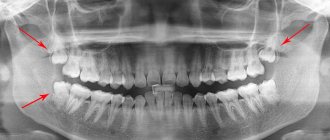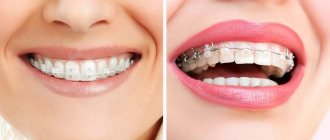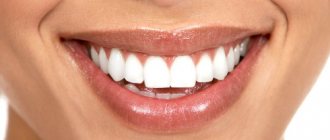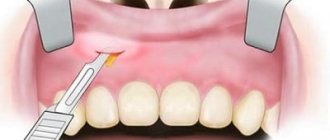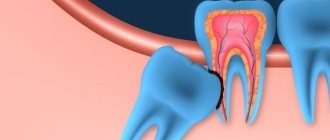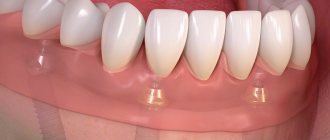Wisdom teeth are vestiges that appear in a person as an adult. Wisdom teeth are vestiges that appear in a person as an adult. Often, if a wisdom tooth begins to grow, this is accompanied by various pain sensations. This is why almost every person wants to have their wisdom teeth removed.
But are such rudiments so useless? If you notice signs of a wisdom tooth, it is better to immediately go to a specialist. He will help you decide whether to keep the tooth or whether it is better to get rid of it right away.
Are wisdom teeth necessary?
When wisdom teeth begin to appear, the question arises: are they really necessary for a person? It is easy to find out that a wisdom tooth is cutting: characteristic pain occurs. If the erupted rudiments interfere or cause discomfort, they can be removed.
Nowadays people eat mainly thermally processed, soft foods. That is, he actually doesn’t need eights, especially since they can get sick. However, dentists say that eights do not allow the jaw to become thinner, and this is a significant plus.
Why does figure eight caries occur?
According to statistics, caries of problem eights is much more common than caries of other teeth. At the same time, the main reasons for the development of carious lesions are not much different from those with damage to any other part of the jaw. These include:
- Hereditary factors.
- Poor hygiene.
- Excess sugars and fast carbohydrates in daily nutrition.
- A specific risk factor is the location of the third molar. Typically, the wisdom tooth erupts at an angle, which makes it difficult to properly clean it during daily hygiene procedures. In hard-to-reach areas, food debris accumulates, which serves as a breeding ground for bacteria. By fermenting carbohydrates, bacteria produce organic acid, which leads to caries of the upper or lower 8 teeth.
How long does it take for wisdom teeth to erupt?
How does a wisdom tooth grow?
If there is enough space on the jaw, teething occurs almost asymptomatically. The growth of wisdom teeth depends on several factors:
- molar position;
- jaw size;
- availability of space for eight.
If there is little space when wisdom teeth begin to grow, they appear over the course of several years. As for pain, the question “how much does a wisdom tooth hurt” cannot be answered unequivocally. The process occurs individually for each person.
- If the jaw is small and the beginning of eruption is noted, it may be significantly delayed. The pain during the eruption of a wisdom tooth can be severe. In addition, in this case, dystopia (improper position of the molar) may be observed.
- If the jaw is of normal size and a wisdom tooth has begun to grow, it will appear fairly quickly. How long will he be sick in this case? The pain is usually mild and intermittent.
When wisdom teeth grow in full, the discomfort disappears. And if they do not cause any discomfort, they are not removed.
Removal Features
As a rule, operations to remove third molars are always considered difficult, since these are the teeth that usually cause more problems. The operation can be simple, provided that the “figure eight” is located on the upper jaw and does not have pronounced developmental abnormalities. In all other cases (as well as in situations where the tooth is in the upper jaw, but has strong, curved and branched roots), the operation is considered complex and must be performed by a qualified dental surgeon.
Before performing an intervention, the doctor determines possible contraindications for a particular patient, examines an x-ray of the problem area and determines the optimal tactics for the operation. The duration of the procedure ranges from 1-10 minutes for simple removal and up to 20-120 minutes for complex removal, requiring a series of manipulations and suturing of the hole.
Features of wisdom teeth growth
If a wisdom tooth is cut, complications can sometimes arise.
How does a wisdom tooth grow? If there is enough space on the jaw, teething occurs almost asymptomatically. Minor pain may be present, but it does not cause severe discomfort.
If a wisdom tooth is cut, complications can sometimes arise:
- Dystopian teeth. Characterized by the fact that the wisdom tooth on the lower jaw takes an incorrect position. As a result, he may begin to injure his cheek.
- Impacted teeth. In this case, the wisdom tooth with its roots is located under the gum and does not erupt at all. This can cause an inflammatory process.
- Semi-retinated teeth. In this case, the eruption of the wisdom tooth does not occur completely. Because of this, the mucous membrane is in a tense state all the time.
- How to determine how a wisdom tooth is growing? Pain may occur when chewing or moving the jaw. If you feel the gum, you can feel that there is a tooth there.
- When wisdom teeth grow, there is often a pain in the throat and in the head. If the figure eight is positioned incorrectly, the discomfort will intensify.
- When wisdom teeth appear, eruption occurs in stages over several months. It can cause the position of other teeth in the jaw to change.
- If a large wisdom tooth cannot erupt normally, it can open access to other tissues of the jaw. This may increase the risk of infection.
- The eruption of wisdom teeth in adults may be accompanied by increased pain at night. If you have a habit of clenching your jaw, you may experience extremely unpleasant sensations at night. Also, when wisdom teeth start to come in, you should not use chewing gum.
- A small portion of the gum above the tooth may be visible. The roots of the wisdom tooth will not be noticeable. The presence of a gingival hood is not a problem.
- The wisdom tooth in the upper jaw is often accompanied by swelling. This may make it difficult to open your mouth. This condition can last for several days, and then you have to drink through a straw.
Signs of wisdom tooth eruption can be briefly described as follows:
- a small amount of blood
- slightly protruding tooth
- saliva mixed with blood.
But such symptoms are not always observed. The main signal for you should be the presence of pain.
Signs of an unformed eight
It also happens that the last molars never appear. They remain in the jaw or under the gum tissue . This is the so-called tooth retention. It can be observed for several years without disturbing the person.
But most often the last molars put pressure on the neighboring ones and cause their destruction. This is accompanied by severe pain not only in this place, but throughout the jaw, gums and even in the throat.
An undetected “figure eight” can cause severe complications. Often the patient cannot associate the deterioration of the condition, headaches and inflammation of the tonsils with the problems of the wisdom tooth.
How to understand that a wisdom tooth is cutting: symptoms of growth and eruption
Most often, the hood of a wisdom tooth is not a problem, but sometimes its edge can get caught when the teeth are closed between them and become injured and cause pain.
The growth of wisdom teeth is most often accompanied by pain in the jaw. This is how the “eight” tries to break through the bone tissue. One should take into account the fact that the jaw of an adult is already fully formed.
How to understand that a wisdom tooth is growing? Symptoms of wisdom tooth growth are:
- Pain (mild to severe): sore gums, pain in the head, throat or ear, difficulty swallowing. The eruption of wisdom teeth is sometimes accompanied by pain from infection. If your throat hurts, in this case it is better to consult a specialist to prescribe treatment. If a wisdom tooth hurts when pressed, this may indicate that it is growing crookedly. “Eights” climb last, so they may simply not have enough space. How does a wisdom tooth erupt in this case? It grows as it will.
- Inflammation of the gums : sometimes a “hood” of mucous membrane can form, bacteria can multiply under it, and bad breath may appear. An increased risk of dental caries may favor molar removal. Symptoms of wisdom teeth erupting also include damage to the gum shell. Sometimes this can lead to gum disease, and the pain from the tooth can radiate to another tooth nearby.
- Swelling of the tongue, mucous membrane or cheek (rarely): signs of wisdom tooth growth are also expressed in the presence of edema. There may be difficulty swallowing. Sometimes symptoms of intoxication may appear.
- If a wisdom tooth is cut, symptoms may include enlarged lymph nodes under the jaw . The temperature may rise to 40 degrees.
- The feeling that a wisdom tooth is in the way is a fairly common situation. This usually happens due to lack of space for it. Eventually it will either level out or have to be removed. If a wisdom tooth hurts when pressed, this may indicate that it is growing crookedly. “Eights” climb last, so they may simply not have enough space. How does a wisdom tooth erupt in this case? It grows as it will.
- Itching : When your wisdom tooth itches, it may indicate gum damage. Signs of a molar appearing may be accompanied by damage to an adjacent tooth or inflammation of the gums. If there is severe itching that the patient cannot tolerate, you should immediately consult a specialist.
So, when a wisdom tooth comes out, it’s clear what symptoms appear.
When a wisdom tooth grows, all or several symptoms may appear. They can vary in duration and intensity.
So what do we do with eights?
The moral of this story is this: trust qualified and educated doctors, not kind and humane “neighborly” advice. Be wise. Especially at such crucial moments in life, when wisdom teeth make themselves felt. And in general, I wonder who was the first to call them “wisdom teeth”?
Moreover, an interesting point from medical practice: if you (what if?) decide to remove the eights, it is not a fact that they will be removed for you. The reason is simple - wisdom teeth must be removed exactly according to indications. A normal doctor will never remove a healthy tooth just because you want it.
You have decided to remove your wisdom teeth. How traumatic is this?
If the wisdom tooth has grown normally, its roots are not intertwined, removal usually takes place without any complications. The edges of the tooth socket after extraction are often not even sutured.
What is most important after removing the figure eight is to allow the socket of the just removed wisdom tooth to heal. Quite a big wound.
What is absolutely impossible to do?
You should not rinse vigorously, even with such seemingly beneficial solutions as chamomile or calendula.
What needs to be done.
To get rid of food debris, you need to carefully take water into your mouth and do short oral baths without intensive rinsing. Instead of water, you can use a solution of chlorhexidine, miramistin or analogs specially sold in pharmacies - they disinfect the oral cavity. And so - for at least three days. If this recommendation is neglected, the hole may become inflamed. Then the dentist prescribes treatment with medications, including antibiotics.
What if the roots of an insidious wisdom tooth are intertwined or fused?
Unfortunately, in this case complications cannot be ruled out - soft tissues may be damaged. If an inflamed tooth is removed, in rare cases the neurovascular bundle (!) of the lower jaw is injured. In this case, separate treatment may be required.
When eights hurt: possible complications
It is extremely rare for figure eights to erupt painlessly.
They are often in the wrong position. It is extremely rare for figure eights to erupt painlessly. They often take an incorrect position, which is characterized by soft tissue injuries. Sometimes molars damage neighboring molars.
When wisdom teeth growth symptoms result in pain, this can be completely normal. Regular teeth behave similarly during growth.
If you see signs of wisdom teeth erupting in the form of swollen gums and a feeling of pressure, there is nothing to worry about. Symptoms of a wisdom tooth erupting in the form of severe pain should alert you. If the symptoms of wisdom teeth erupting cause unbearable pain, it is recommended to consult a specialist. The dentist will assess the condition of the tooth and help avoid risks.
To sum up, we can say: how the figure eight erupts is a complex question; this process occurs differently for all people.
Inflammatory processes
Signs of the appearance of a wisdom tooth due to improper eruption can be expressed in the manifestation of complications:
- flux;
- phlegmon - purulent inflammation;
- osteomyelitis - inflammation of bone tissue.
Symptoms when a wisdom tooth is cut, in the latter case, are expressed by diarrhea, high fever, vomiting and nausea.
Inflammation of a wisdom tooth occurs due to damage to the gums, dental or bone tissue. Sometimes it occurs due to pressure placed on adjacent molars.
If the gums become inflamed, it is called pericoronitis. While the gums have not yet become very swollen, you should consult a specialist.
When a lymph node becomes inflamed due to a wisdom tooth, if the inflammation is small, this is considered normal. In this case, nothing is done regarding the lymph nodes. They're just waiting for the swelling to go down.
If the node has become severely inflamed, you should consult a dentist. He will assess the condition of the lymph node and tell you what to do about the swollen gum. In this case, the tooth is usually removed.
Temperature
If a wisdom tooth is coming out, fever is usually a common symptom. If it stays at 37.5, this is absolutely normal.
In general, when a wisdom tooth is cut, the temperature depends on the severity of the inflammation. With suppuration, its level may be higher. The temperature during the growth of a wisdom tooth can also increase against the background of colds.
Pain in the ear, throat
Can wisdom teeth cause ear pain? The answer is yes, because the face has a specific physiology. The organs of the mouth, vision and hearing are interconnected.
The wisdom tooth extends into the ear due to the trigeminal nerve. It occupies most of the face, starting at the temple on the left and right sides. This explains why the ear hurts due to wisdom teeth.
Can a wisdom tooth cause a sore throat? The throat may suffer if the lower molar is cut. A sore throat due to a wisdom tooth is due to the fact that it pushes the roots of neighboring teeth apart, which causes pain in the chewing muscles.
If you have a sore throat from a wisdom tooth, your doctor will determine the symptoms and treatment. Standard painkillers and antiseptic rinses usually help relieve pain.
Headache
Can wisdom teeth cause headaches? If there is an inflammatory process in the body, it may well be accompanied by this type of pain.
When a wisdom tooth grows, the headache is due to the development of caries in it, or because of a cyst that disrupts the blood supply. Sometimes wisdom teeth cause headaches due to malocclusion. In this case, pain occurs in the occipital, parietal and parotid areas.
Jaw and jaw joint
Can wisdom tooth pain in the jaw when pressed? Yes, this is possible for several reasons. The most common of them are malposition of the molar, caries, and inflammation of the periosteum.
If a wisdom tooth grows and your jaw hurts, this may be caused by the fact that the figure eight puts pressure on other teeth. They shift, which is why the jaw joint usually hurts. The intensity of pain may vary.
Gums hurt
When a wisdom tooth is cut, the gums hurt due to improper eruption.
When a wisdom tooth is cut, the gums hurt due to improper eruption. In this case, pericoronitis may even develop.
The wisdom tooth tears the gum, and pathogenic bacteria that collect in the gum pockets cause swelling. If a wisdom tooth is cut, the gums become inflamed, the pathology can grow.
If a problem occurs, you should immediately contact a specialist. When a wisdom tooth cuts the gum, infectious processes may occur that will try to penetrate deeper.
Injury to the mucous membranes: cheeks hurt
If a wisdom tooth cuts into the cheek, this is a rather serious problem. As you know, the figure eight grows for a long time, and this, in turn, makes it possible to notice its incorrect location at the initial stage of growth and determine all possible consequences.
Modern dental technologies make it possible to identify the problem in advance and eliminate its beginnings before the wisdom tooth grows into the cheek. Thanks to this, it became possible to prevent complications associated with damage to the buccal mucosa. The advantage of such an operation is that it takes place with minimal consequences, and there are practically no complications.
When a wisdom tooth grows towards the cheek, it must be removed without hesitation. This position is fraught with damage to the mucous membrane of the inner surface of the cheek. As a result, inflammation and ulcers may appear, which may even have oncological consequences in the future.
If a wisdom tooth is rubbing your cheek, you will have to remove it. This operation refers to atypical surgical operations. After this, complications may arise due to the fact that the roots of the tooth are quite deep and large.
If a wisdom tooth grows, your cheek hurts, it is removed. After this, the person may experience pain for some time, which gets worse when eating. In this case, dentists advise rinsing your mouth with a soda solution after each meal.
In addition, when the wisdom tooth hurts, the cheek is swollen and the gums hurt, herbal decoctions (for example, chamomile) contribute to the speedy healing of the gums. Don't hesitate if your wisdom tooth touches your cheek. Remember, the sooner you see a dentist, the sooner you will protect yourself from possible complications.
If the tooth begins to rub painfully, it can end in disaster. In some cases, serious inflammation may develop.
Pain
When a wisdom tooth comes out, inflammation and swelling of the gums are accompanied by pain. Sometimes a liquid secretion and pus are released.
Pulsating pain in the wisdom tooth is observed in the presence of extensive swelling. To prevent complications in this case, you should consult a specialist.
Pain relief from wisdom teeth can be relieved by painkillers. Doctors also recommend rinsing your mouth with antiseptic compounds.
Aching pain in a wisdom tooth usually occurs within the first day of its eruption. In this case, the lower molars bother patients more often than the upper ones. If your wisdom tooth hurts, it can get to the point where it becomes difficult to move your jaw.
When a wisdom tooth grows painfully, this indicates that inflammation has spread to the muscle corset. Moreover, in this case, the molar begins to react painfully to sour, hot, cold and spicy.
The wise tooth usually hurts at the slightest careless movement. Rinsing your mouth, brushing, chewing food - everything causes discomfort.
Can another tooth hurt because of a wisdom tooth? Yes, this happens often. However, over time, relief does occur in such a situation.
If your wisdom tooth hurts badly and you are at work, you can take a painkiller tablet. If the pain does not subside, you should consult a doctor.
Sometimes your wisdom tooth hurts at night. This is also completely normal. In this case, you will have to be patient.
So, can wisdom teeth hurt? Yes, it definitely can. But sometimes it does not cause any discomfort.
Help with home remedies -
As we said above, only with minor discomfort and inflammation can you cope with the situation with home remedies. It is better to use analgesics from the NSAID group (non-steroidal anti-inflammatory drugs) as an anesthetic. These drugs (for example, based on ibuprofen) have not only analgesic, but also a pronounced anti-inflammatory effect. If there are symptoms of inflammation of the hood above the wisdom tooth, it is necessary to use antiseptic rinses and anti-inflammatory gel applications.
- Chlorhexidine solution 0.5% - rinse 2-3 times a day for 1 minute, the solution is sold at the pharmacy ready to use. Immediately after rinsing, blot the gum above the wisdom tooth with a dry gauze swab and apply anti-inflammatory gel (it adheres better to dry mucous membranes).
- Applications of Cholisal gel are carried out 2-3 times a day, immediately after antiseptic rinsing. The gel is applied with light massaging movements to the hood area, then apply another portion of the gel to the hood without rubbing it. After application, it is not advisable to eat or rinse your mouth for 2-3 hours (you can drink). By the way, this gel not only relieves inflammation, but also has an analgesic effect.
However, keep in mind that if you have swelling of the cheek, difficulty opening your mouth, painful swallowing, suppuration from under the hood, swelling and pain in the submandibular area, you cannot self-medicate and should urgently consult a doctor. We hope that our article on the topic: How wisdom teeth are cut was useful to you!
Sources:
1. Higher prof. the author's education in surgical dentistry, 2. Based on personal experience as a dental surgeon, 3. National Library of Medicine (USA), 4. “Pathology of wisdom teeth eruption” (Rudenko A.), 5. “Qualified removal of third molars” ( Asanami S.).
Lack of space during teething
If a wisdom tooth begins to interfere with other teeth and cannot grow, the pain can be severe. Also, when a molar begins to touch other teeth, many complications can arise. In this case, the orthodontist, after examining the mouth, most often decides to remove the tooth.
Sometimes, if there is no room for normal eruption, the molar does not fully protrude. Then, as a rule, inflammation occurs. Then a decision is also made to remove the eight.
Deformation of the dentition
Incorrect growth of figure eights can ruin the bite. Displacement occurs due to pressure exerted on adjacent teeth. As a result, the entire dentition may become deformed.
Also, due to the growth of eights, various tumors may appear. Then they will have to be removed and the teeth restored.
Difficulty erupting wisdom teeth
The eruption of wisdom teeth can be difficult. Usually soft tissues and mucous membranes are damaged. The tooth itself may develop pulpitis, caries or periodontitis.
How do you know if your wisdom tooth is growing correctly? In this case, it does not cause severe discomfort. If a molar grows crookedly, the teeth become displaced due to wisdom teeth.
How to understand that a wisdom tooth is growing incorrectly? He begins to move the neighboring sevens. In this case, the person experiences severe pain.
The way a wisdom tooth erupts determines whether it should be preserved or removed. If a molar begins to erupt crookedly, it is better to remove it immediately.
Retention of wisdom teeth
Not all molars emerge normally from the gums when wisdom teeth erupt.
Not all molars emerge normally from the gums when wisdom teeth erupt. If the tooth is partially or completely embedded in the gum, this can lead to health complications. Then it should be removed.
Among the main reasons for retention are:
- crowded teeth;
- heredity;
- dense gum walls;
- early loss of baby teeth.
Wisdom tooth dystopia
Dystopic is a tooth that is located incorrectly relative to the dentition. This pathology can harm other teeth. Specialists who discover a dystopic tooth almost always decide to remove it.
Dystopic teeth cause a number of unpleasant sensations. Often its growth is accompanied by pain and inflammation.
Complete retention of wisdom teeth
Retention is a condition when a tooth cannot erupt. If the dental surgeon sees that the tooth does not show out at all, this is called complete retention.
Whether or not to open the hood in this case is decided individually. If the tooth does not bother you, leave it alone. And if a cyst has formed, it is removed.
The main causes of pain
Painful symptoms from wisdom teeth are caused by the anatomical features of the upper and lower jaw, which are already fully formed in a person at the age of 17-25.
As the figure eight begins to grow, it puts pressure on neighboring teeth, bone and soft tissue. The growth process can last for months and even years, so pain manifestations are temporary, periodically fading and exacerbating.
The pain of tooth 8 can be provoked not only by its growth or anatomically incorrect position, but also by the presence of various pathologies, for example, caries, pulpitis, periodontitis or a wide range of infectious diseases. Note! The lack of timely professional help can provoke a worsening of the situation, which will result in the need to remove the diseased tooth and treat complications.
What you should and should not do if your wisdom tooth hurts
If erupted wisdom teeth hurt, treatment is required. Typically, ibuprofen-based NSAID analgesics are prescribed. For each specific case, treatment is selected individually.
If teeth have not yet erupted, topical gels can be used. Kamistad or Cholisal is applied to the gums. However, it is important to understand that the effect will be short-lived.
The best choice would be to see a dentist. Sometimes an extracted tooth can also bother a person. Then you should not endure the pain, you need to consult a specialist.
Signs associated with gum disease
To one degree or another, it develops in all people when the “eight” appears. The most extreme position in the dentition leads to the formation of a “hood” of mucosal tissue.
After eating, food debris accumulates there, and with normal hygiene procedures it is very difficult to remove them from there. Therefore, bacteria develop in this pocket , causing an inflammatory process .
For some people, it is almost painless and goes away on its own. But quite often various complications appear. During chewing the gums can become damaged , bacteria enter the wound, and inflammation develops into pericoronitis .
Ulcers appear on the cheek and oral mucosa, which cause severe discomfort and cause the development of stomatitis . An abscess may form on the gum due to infection.
In case of problems with the upper molars, the inflammation can spread to the trigeminal nerve, which causes severe unbearable pain. The lower teeth cause complications on the tonsils and throat. Often, there is an increase in temperature and enlargement of the lymph nodes.
